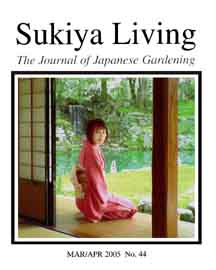|
Sukiya Living Magazine
Japanese Textiles
 The
world of Japanese textiles is stunning in its complexity and beauty.
From kimono to tatami to washi paper: the array of materials and techniques
is mind-boggling.
The
world of Japanese textiles is stunning in its complexity and beauty.
From kimono to tatami to washi paper: the array of materials and techniques
is mind-boggling.
At the heart of it all is the Japanese Kimono. The kimono is the most classic form of Japanese clothing. Often made of silk, and nowadays worn mainly by women, Japanese kimonos come in an unlimited number of colors and kimono patterns. Kimonos are the best known form of Japanese traditional clothing and can still be seen every day on the streets of Kyoto and in other "traditional" settings such as in Japanese inns and restaurants. A type of summer kimono known as the yukata is particularly popular.
Other types of Japanese fabric also have had distinguished histories and prominent roles in Japanese culture. During the Edo Period Japan had surprisingly complex weaving and indigo dye industries. Traces of those great traditions can be found at flea markets and Japanese antique stores. One look at the delicate embroidery of a vintage kimono or kimono sash says it all.
Sukiya Living Magazine periodically publishes articles that are related to Japanese textiles. SLM's Art Director, Tamao Goda, is a huge kimono enthusiast and wears a Japanese kimono to work every day. Because of this we probably feature a few more articles on Kimono than on, say, Japanese baskets or Japanese papermaking. Published articles can generally be grouped into the following categories:
-----------------------------------------------------
JAPANESE FABRIC These articles are about Japanese fabrics and how they are made. Silk is perhaps the best known fabric from Japan, but there are others, too.
TRADITIONAL JAPANESE CLOTHING Over the centuries the classic kimono hasn't been the only type of clothing worn in Japan. Read these articles to learn more.
KIMONO These articles are about the traditional Japanese kimono. Topics include how to make a kimono and how to wear one properly. Read these articles if you want to buy a Japanese kinono or even if you just want to hang one on the wall as a kind of Japanese decor.
TATAMI MATS Most of our tatami articles are related to Japanese interior design, but some aspects of tatami mat making are of interest to textile enthusiasts, also.
JAPANESE BASKETS In the West, the beauty of the Japanese basket tradition is not well known. Japanese baskets are made of bamboo and other materials and are great examples of Japanese craftsmanship.
JAPANESE PAPER The Japanese paper used in shoji doors should be called washi, not "rice paper." That is just one of the interesting facts you can learn by reading these articles about papermaking and the role of paper in Japanese culture.
ORIGAMI The king of paper-related hobbies is, without a doubt, origami. Some might even call origami an art form. Read these articles for more information about origami and origami paper. Included are a few articles that provide origami instructions for making some of Japan's most famous origami pieces.
------------------------------------------------------